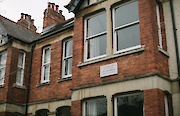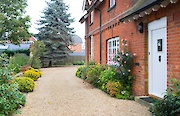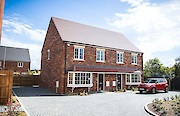


Head of Content

Mortgage Advisor & Director

When it comes to purchasing a home, getting a mortgage can be one of the most significant challenges. But what exactly classes a house as uninhabitable for a mortgage? Understanding the requirements and factors that impact mortgage eligibility is crucial for homebuyers and property investors alike.
In this article, we'll delve into the essential requirements for mortgageability, the impact of roof types on mortgage approval, how to deal with uninhabitable property issues, alternative financing options, and more.
Essential requirements for habitability
To get a standard residential mortgage on a property, there are essential requirements that must be met, including a functional kitchen and bathroom, and a safe, sound and weatherproof structure free from health hazards, such as mould or damp problems.
A property that fails to meet these requirements may be considered uninhabitable and thus, ineligible for a mortgage. Navigating the mortgage process can be a challenge, but understanding these fundamental criteria can help you work with mortgage brokers and lenders to secure the best mortgage possible for your property purchase.
Functional kitchen and bathroom
A functional kitchen and bathroom are usually fundamental requirements for getting a residential mortgage. For a kitchen to be considered functional, it must have running water and a sink. Without these necessities, mortgage lenders will not typically approve a loan for the property. Similarly, a functional bathroom must have hot and cold water and a toilet.
Meeting these lending criteria is essential for a successful mortgage application. It is crucial to ensure that the kitchen and bathroom in the property you are looking to purchase meet these requirements. Failing to do so can result in difficulties obtaining a standard mortgage and could potentially leave you with an uninhabitable property.
Safe and sound structure
A safe and sound structure is another vital requirement for mortgage eligibility. This means that the property must be structurally sound, free of defects, flaws, decay, or deterioration, and capable of withstanding the loads it is designed for or exposed to. In some cases, you may be able to use a bridging loan, a renovation mortgage or another type of finance to address structural issues before applying for a standard mortgage.
Structural issues, such as subsidence or root damage, can make a property uninhabitable or unmortgageable, but experienced developers may be able to fix them at a below-market price offer. When evaluating a property, it is essential to identify and address any structural issues that may arise. Failure to do so may result in a property that is deemed uninhabitable, posing a health risk to occupants and mean that securing a mortgage is difficult.
How roof types affect mortgage approval

The type of roof on a property can also impact mortgage options for habitable properties. Certain roof types, such as flat, felt, thatched, or tin roofs, or damaged slate or tiles, may render a property ineligible for a mortgage. Watertight and windproof conditions are necessary for a roof to be considered habitable. Understanding the impact of roof types on mortgage approval can help you make informed decisions when purchasing a property.
Let's take a closer look at how different types of roofs, such as slate or tile roofs, flat roofs, and non-standard roofs, can impact mortgage approval.
Slate or tile roofs
Lenders generally prefer conventional roofs constructed of slate or tile. Slate and tile roofs are durable and long lasting, making them a popular choice for mortgage lenders. However, a severely damaged slate or tile roof can impact mortgage approval. It is essential to ensure that a property you are considering for purchase has a well-maintained slate or tile roof to increase the likelihood of mortgage approval.
If you are looking to purchase a property with a slate or tile roof, be sure to inspect the roof's condition and address any damages or issues that may arise. This proactive approach will help ensure that your property meets the requirements for mortgage eligibility.
Flat roofs
Flat roofs can pose a challenge when attempting to obtain a mortgage, as they are more prone to damage and leaks. Lenders may consider the roof's age, condition, and maintenance history on a case-by-case basis when assessing flat roofs. It is essential to demonstrate to the lender that a property with a flat roof is in satisfactory condition and unlikely to suffer any water damage if it is being considered for purchase. Regular maintenance should be performed to ensure the property remains in good condition.
When purchasing a property with a flat roof, it is crucial to inspect the roof's condition and address any damages or issues that may arise. This proactive approach will help ensure that your property meets the requirements for mortgage eligibility.
Non-standard roofs
Non-standard roof types, such as thatched roofs, timber, and concrete panel houses, may have limited mortgage options and may require additional building surveys. Structures that are not constructed with brick or stone and do not have a slate or tile roof are considered non-standard constructions. Not all lenders will accept homes with non-standard construction, and you're likely to pay more to insure a non-standard construction property.
If you are considering purchasing a property with a non-standard roof, it is essential to work with a specialist broker who can provide guidance on the most suitable course of action. This will help ensure that your property meets the requirements for mortgage eligibility.
Dealing with Uninhabitable Property Issues

Uninhabitable properties present unique challenges when it comes to securing a mortgage.
To get a mortgage for an uninhabitable derelict property, a larger deposit and sometimes proof of ability to make necessary repairs may be required. It is vital to understand the lender's views on what they consider uninhabitable and the types of properties they will accept. Potential health risks such as asbestos, mould, and damp issues must be addressed, as well as any fire damage, water supply, drainage and toilets, weatherproofing, non-standard roofs, building regulations, Japanese knotweed, and central heating issues.
Identifying and addressing repairs
If you're in the process of buying a property and suspect that it may have issues that could prevent you from securing a mortgage, it's essential to have a professional home inspection conducted. A home inspector can identify any potential problems with the property, including structural damage, electrical or plumbing issues, or problems with the roof or foundation.
If the inspection reveals significant problems, you may need to negotiate with the seller to have them fixed before closing on the property. Alternatively, you could ask for a price reduction to cover the cost of repairs.
It's always better to be proactive when it comes to identifying and addressing property issues. By taking the time to have a thorough inspection conducted, you can save yourself headaches and financial strains in the long run.
Negotiating with the seller
Negotiating with the seller is another potential step in dealing with an uninhabitable property. This process involves making an offer, counteroffer, and arriving at a mutually agreeable arrangement. Repairs or other contingencies that should be discussed include the condition of the property, the cost of repairs, and any other potential issues.
By engaging in effective negotiations with the seller, you can potentially secure a better deal on the property and ensure that the necessary repairs and issues are addressed. This will make the property more likely to meet the requirements for mortgage eligibility and create a safe and comfortable living environment for the occupants.
How a broker can help you get a mortgage on an uninhabitable property
When dealing with an uninhabitable property, working with a specialist mortgage broker, like the advisers here at Teito, can be invaluable. They can provide expert advice on the remaining options for financing essential repairs, such as using savings, applying for bridging or renovation finance, or asking the vendor to carry out the repairs.
A specialist broker can also help you navigate the complex mortgage process, connecting you with the best mortgage lenders, who are more likely to approve your application and provide mortgage advice tailored to your personal circumstances.
Considering the unique challenges that uninhabitable properties present, partnering with a specialist broker can be a game-changer.
With their expertise and guidance, you can maximise your chances of securing a mortgage for an uninhabitable property and turn it into a comfortable and habitable home.
You can book a free, no-obligation chat with a broker who specialises in uninhabitable property mortgages below:

Connect with an uninhabitable property specialist
Alternative financing options
In some cases, traditional mortgages may not be available for uninhabitable properties. However, alternative financing options exist, such as bridging loans, refurbishment loans, and other short-term finance. These financing options can provide the necessary funds to purchase an unmortgageable home and cover the costs of renovation and repairs.
In this section, we will discuss each of these alternative financing options in more detail, highlighting the benefits and drawbacks of each and how they can be utilised to secure funding for an uninhabitable property.
Bridging loans
Bridging loans are a type of short-term loan designed to provide financing between the purchase of a new property and the sale of an existing property. The primary benefit of bridging loans is that they offer rapid access to funds, enabling you to purchase an uninhabitable house promptly.
They are often used in property development or when buying at auction, providing a convenient solution for borrowers who require quick access to finance.
When considering a bridging loan, bear in mind the higher interest rates and fees associated with this type of financing. While they can provide quick access to funds, they should be used as a last resort and only when other financing options have been exhausted.
Refurbishment loans
Refurbishment loans are short-term financing solutions intended for property investors, landlords, and property developers requiring funds to cover the renovation or repair of a property. They are also commonly referred to as renovation finance or refurbishment mortgages. Refurbishment loans are a type of bridging loan that can be quickly approved and utilised to cover the purchase price and development costs of an unmortgageable property. They offer expedited access to capital, enabling property investors, landlords, and property developers to purchase and renovate properties promptly and effectively.
Refurbishment loans can be a valuable financing option for those looking to purchase and renovate an unmortgageable property. However, as with bridging loans, it is essential to consider the high interest rates and fees associated with this type of financing before committing to it.
Specialist lenders
Specialist lenders may provide loans for partially-renovated non-habitable properties. These lenders often have more flexible lending criteria and may be more willing to work with borrowers who are purchasing properties with unique challenges or risks. It is essential to work with a specialist broker who can connect you with the right lenders for your specific needs and provide expert mortgage advice tailored to your personal circumstances.
Considering the unique challenges that uninhabitable properties present, partnering with a specialist lender can offer a valuable financing solution. With their expertise and guidance, you can maximise your chances of securing a mortgage for an uninhabitable property and turn it into a comfortable and habitable home.
Legal considerations

When assessing a property for mortgage eligibility, it is important to consider legal issues that may affect the property, such as planning permission, restrictive covenants, and any other legal issues that may arise. These legal considerations can have a significant impact on mortgage eligibility and should be carefully reviewed before committing to a purchase.
Below, we discuss planning permission and restrictive covenants in more detail, highlighting how these legal considerations can affect mortgage eligibility for uninhabitable properties.
Planning permission
Planning permission problems can make a property unmortgageable, even if only part of it is non-compliant with the relevant planning regulations. Planning permission is the approval required by law under the Town and Country Planning Act for any proposed building or development. Submitting plans to the local government is necessary for obtaining this approval.
To identify and address planning issues, it is advisable to seek the assistance of a specialist broker who can provide guidance on the most suitable course of action. Ensuring that the property is compliant with planning permission regulations is crucial for mortgage eligibility.
Restrictive covenants
Restrictive covenants are clauses in property deeds that impose restrictions on certain activities being conducted on the land, such as constructing an extension or operating a business. These covenants can affect lenders' ability to register their charge over the property on completion.
It is vital to review the deeds and identify any restrictive covenants that may affect mortgage eligibility. By addressing these legal considerations, you can ensure that the property meets the requirements for mortgage eligibility and create a safe and comfortable living environment for the occupants.
Why choose Teito for your mortgage needs?
At Teito, we have brokers on our team who specialise in mortgages for uninhabitable homes. They have the knowledge and experience to help you navigate the pitfalls of this property type and make sure you end up with the best mortgage for your needs and circumstances.
Here are just some of the reasons why people choose us for their mortgage needs:
- Our brokers specialise in mortgages for uninhabitable properties
- Exclusive rates and deals are available
- We are 5-star rated on leading review websites
- You can secure an agreement in principle in minutes
Ready to take advantage of a free, no-obligation chat with a broker who specialises in uninhabitable property mortgages? Get started here.
FAQs
Unfortunately, it is generally not possible to get a mortgage on a property without a kitchen. This is because both the kitchen and bathroom are essential for any house to be inhabitable, and lenders will usually require that they exist before they approve a mortgage.
It's worth noting that having more than one kitchen can also cause issues when it comes to obtaining a mortgage. This is because multiple kitchens may indicate that the property is being used for non-residential purposes, such as rental or commercial use.
If you're unsure about whether your property meets the requirements for mortgage eligibility, it's best to speak with a professional lender or mortgage advisor. They can provide you with specific information on what is necessary for your property to be considered habitable and help guide you through the mortgage application process.
Choosing an Adviser
Selecting a qualified and experienced mortgage adviser is of great importance. To choose a suitable adviser, evaluate their qualifications, experience, and reputation, and ensure they are regulated by the Financial Conduct Authority (FCA).
Read reviews from previous clients and make sure they provide a clear explanation of the products and services they offer, as well as the fees and charges associated with them.


























































































































































